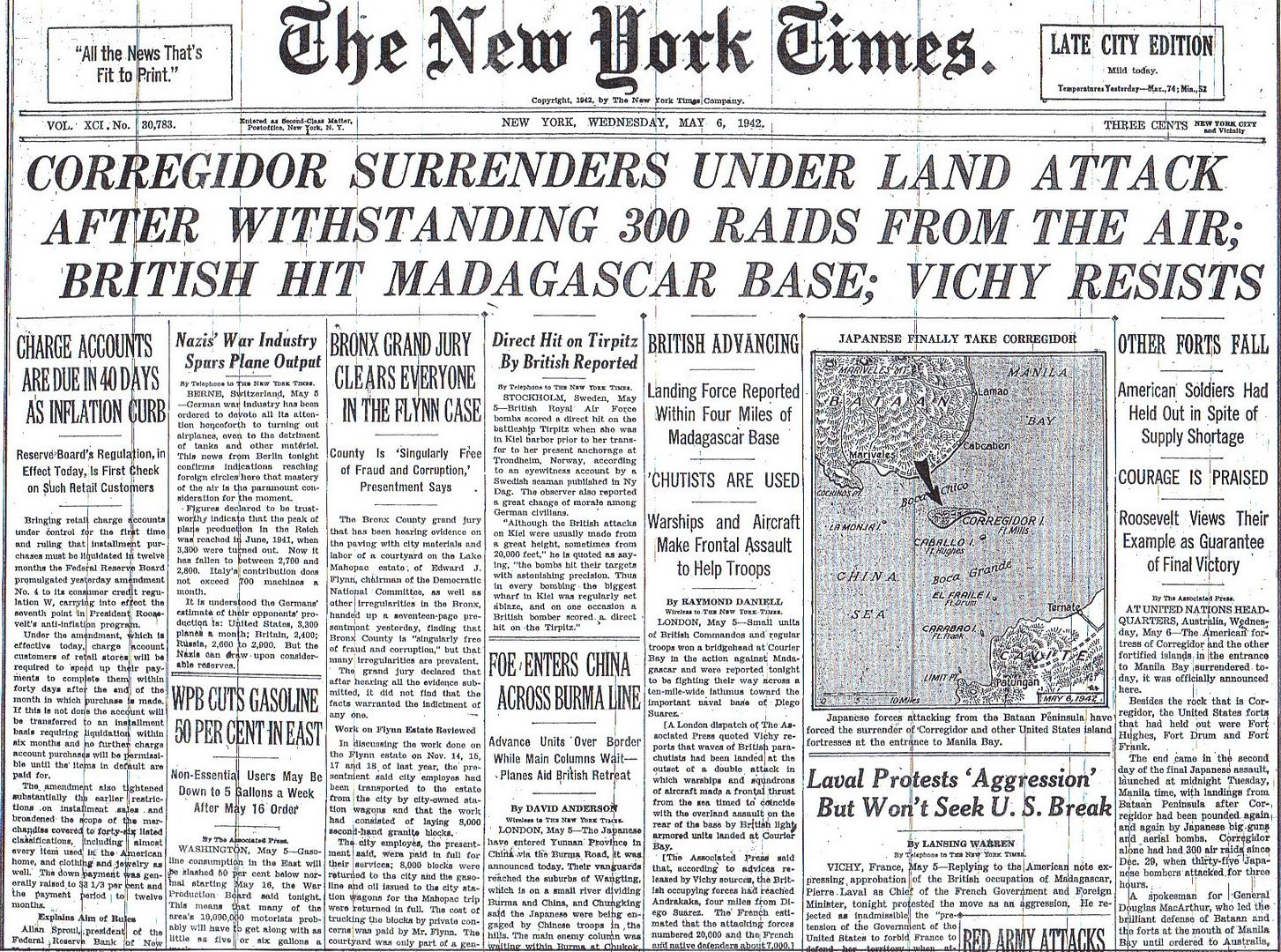
Posted on 05/06/2012 5:11:36 AM PDT by Homer_J_Simpson


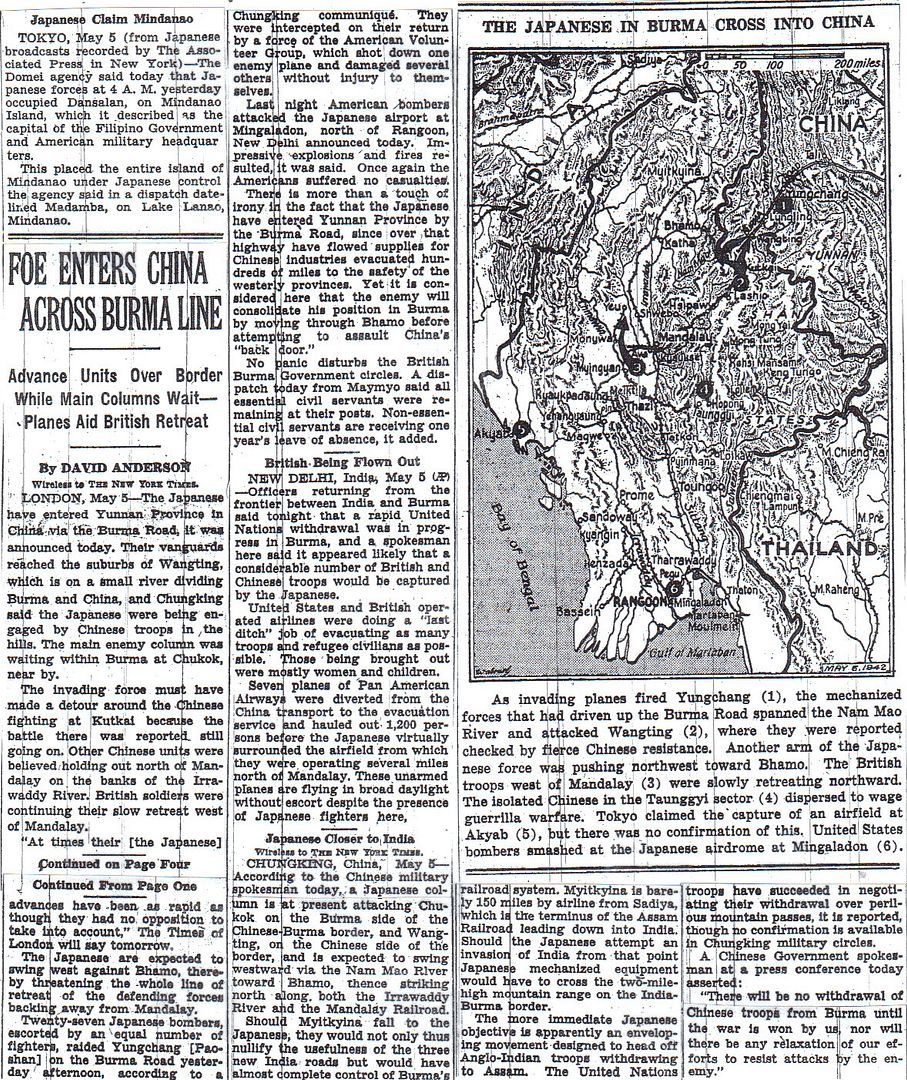

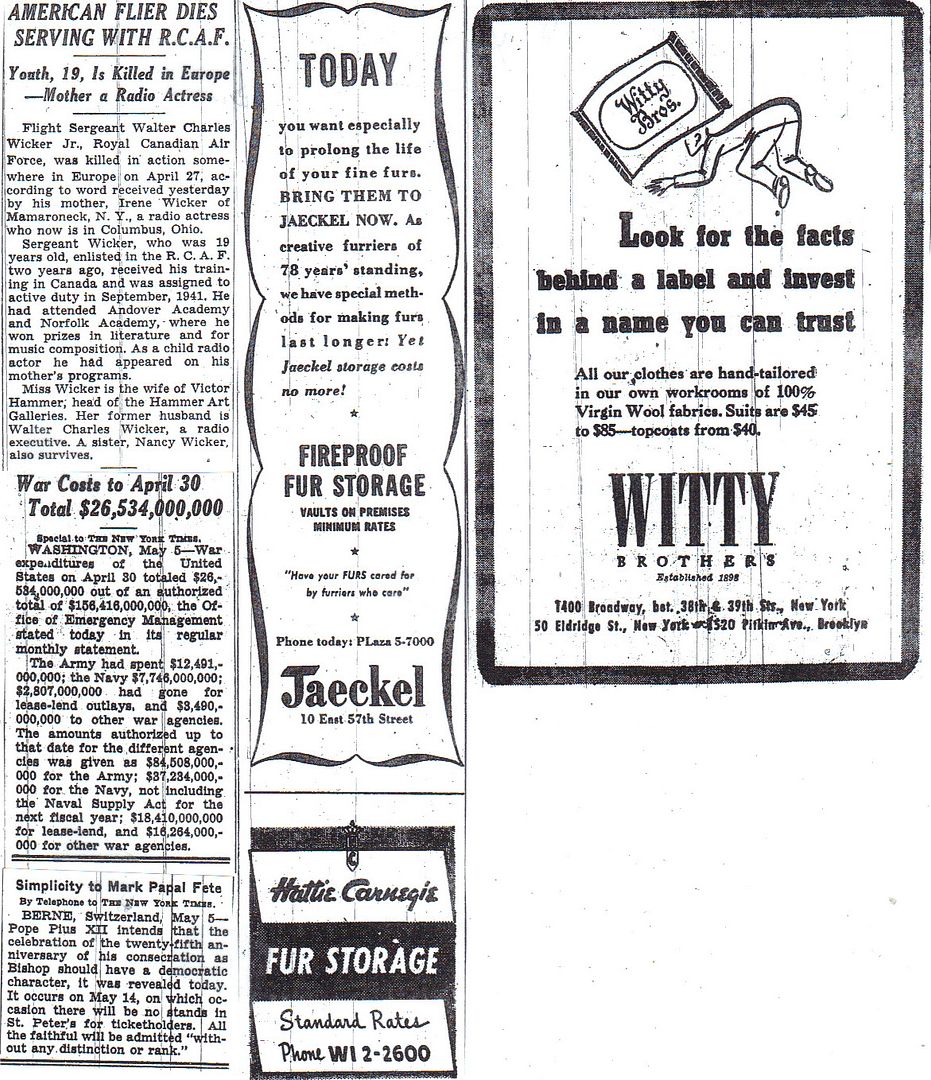
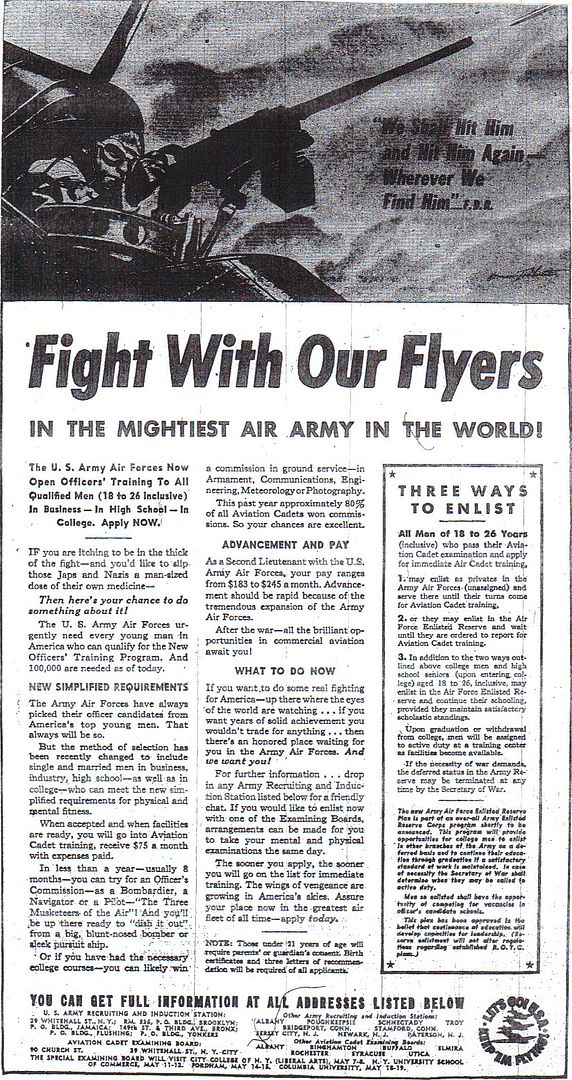

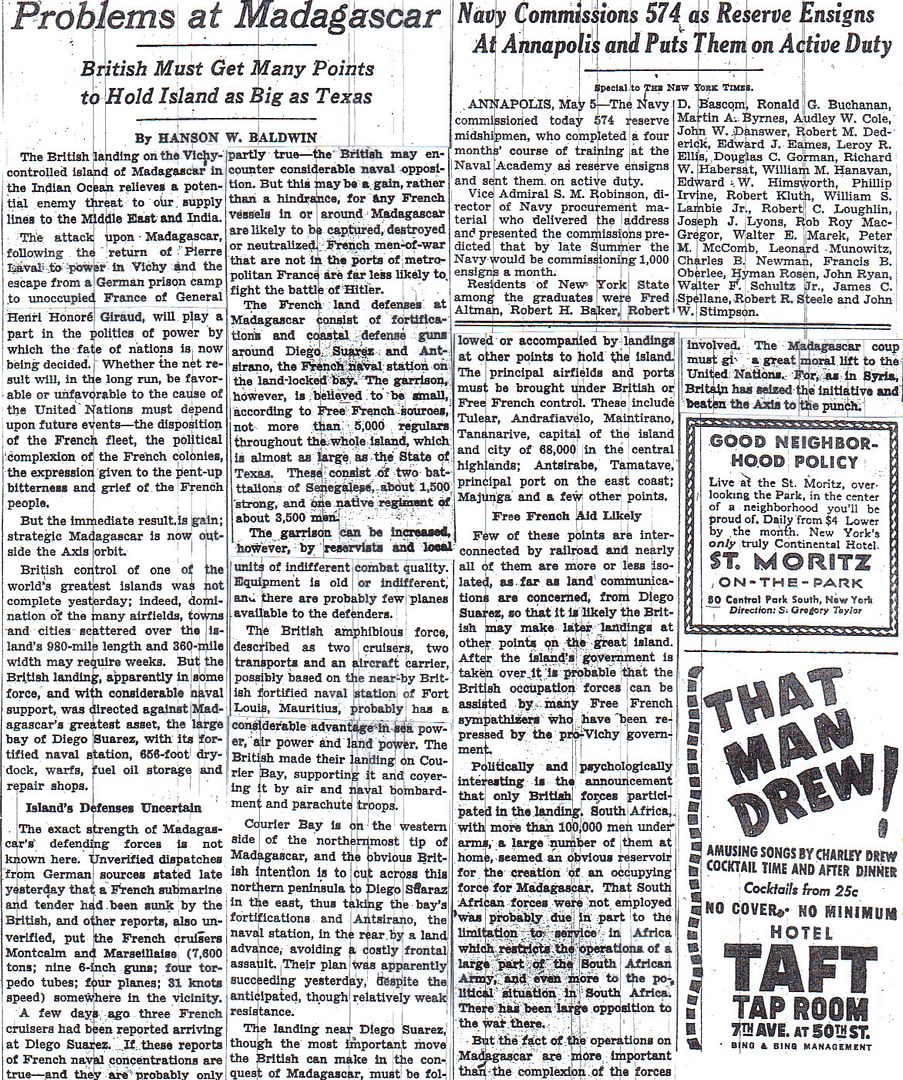
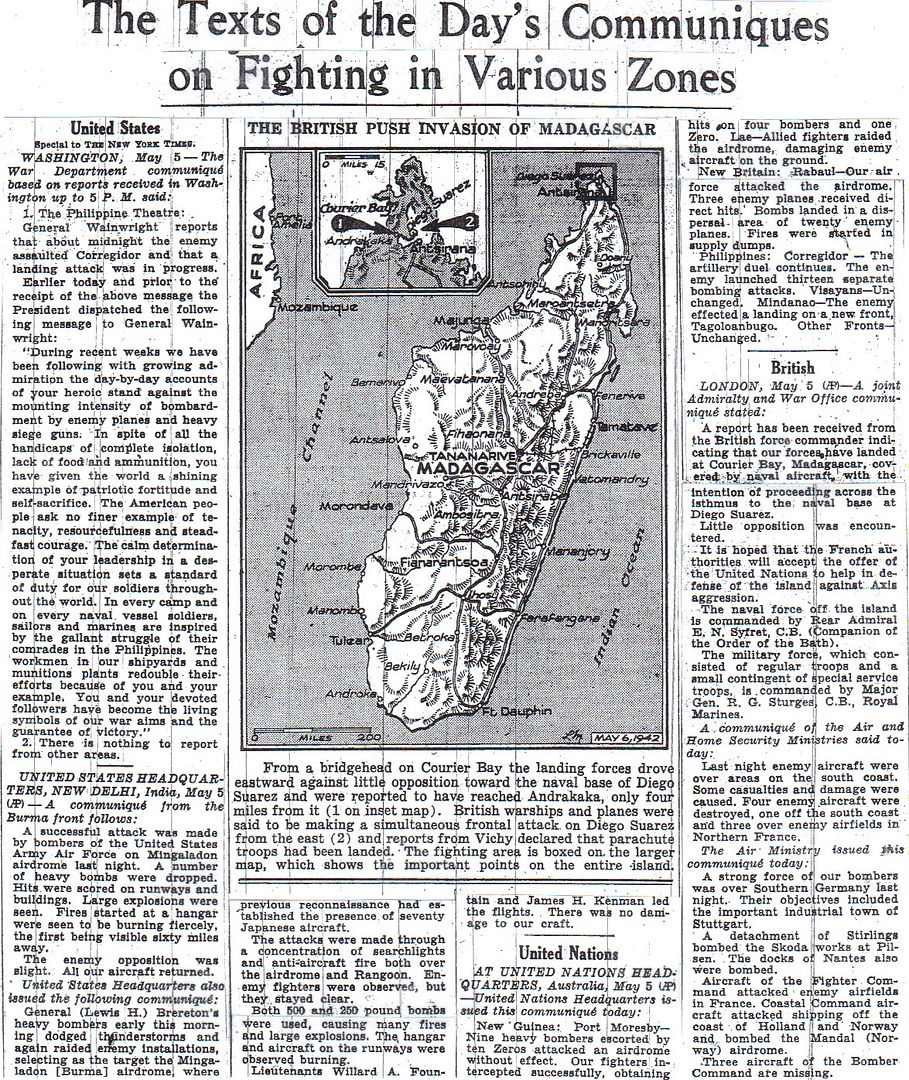
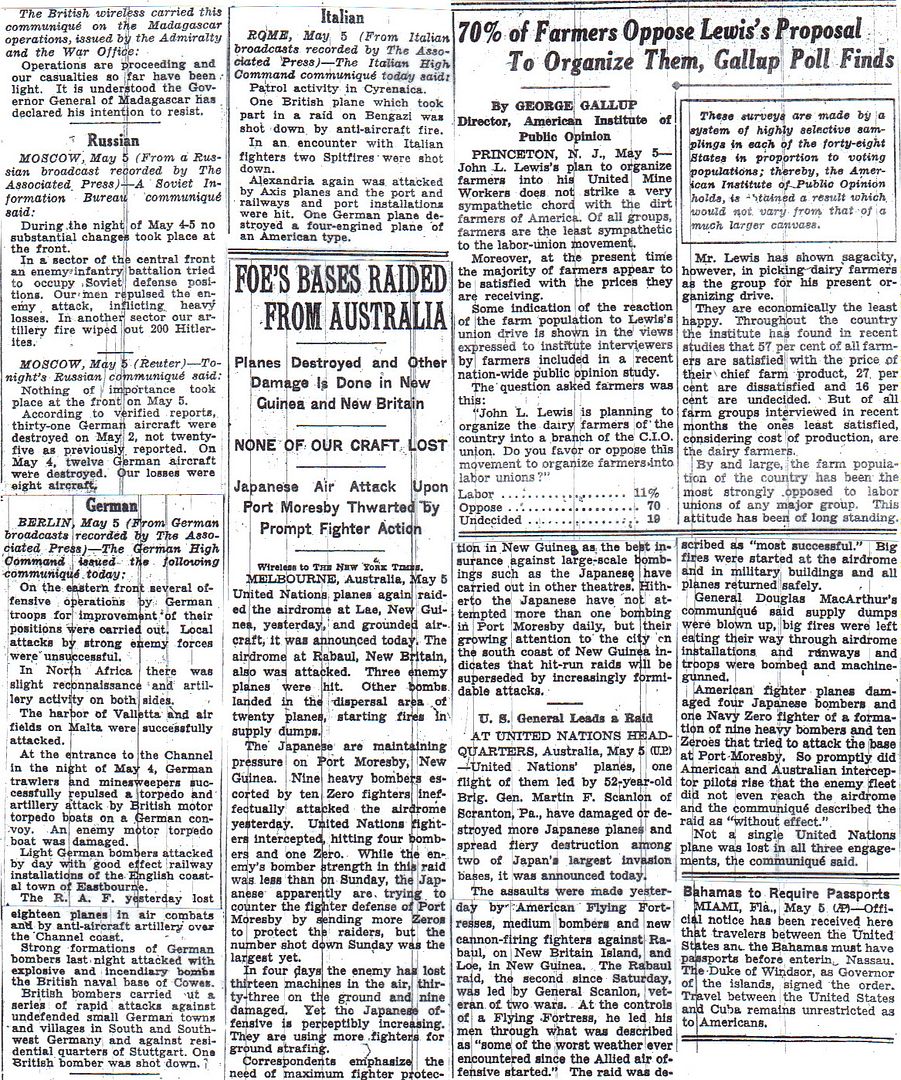
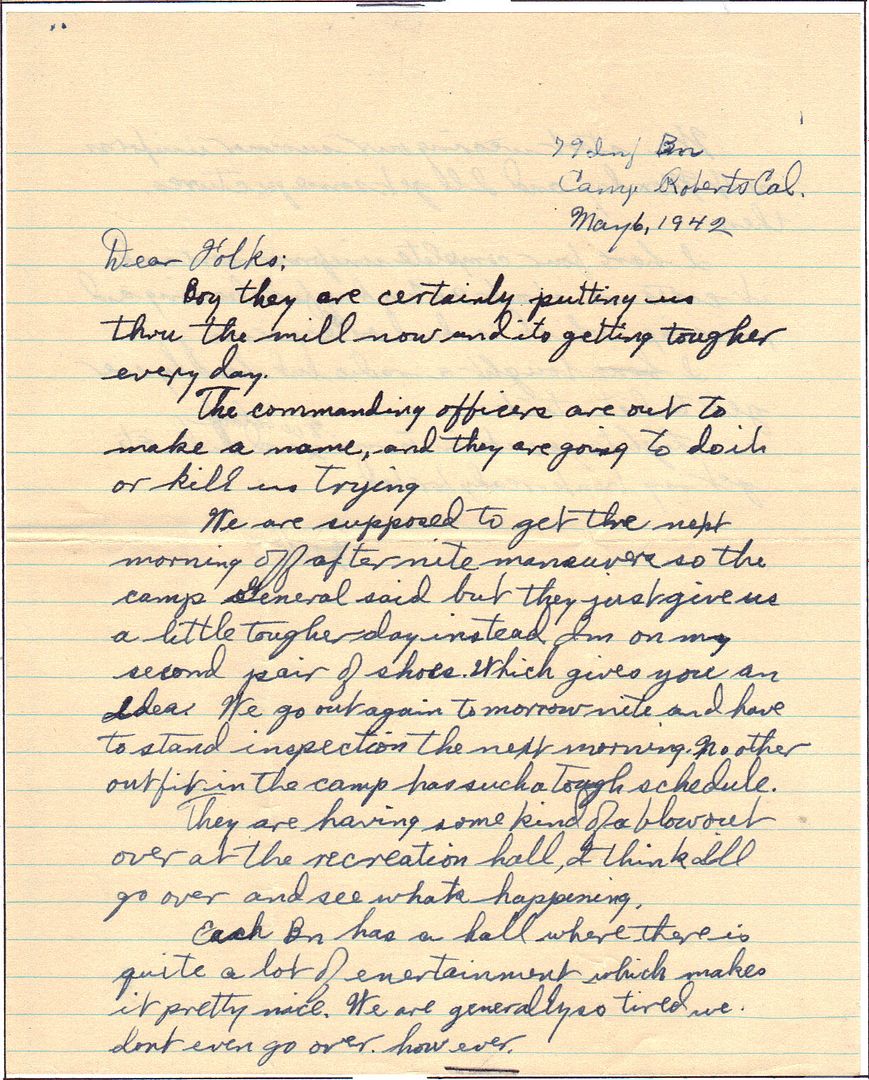
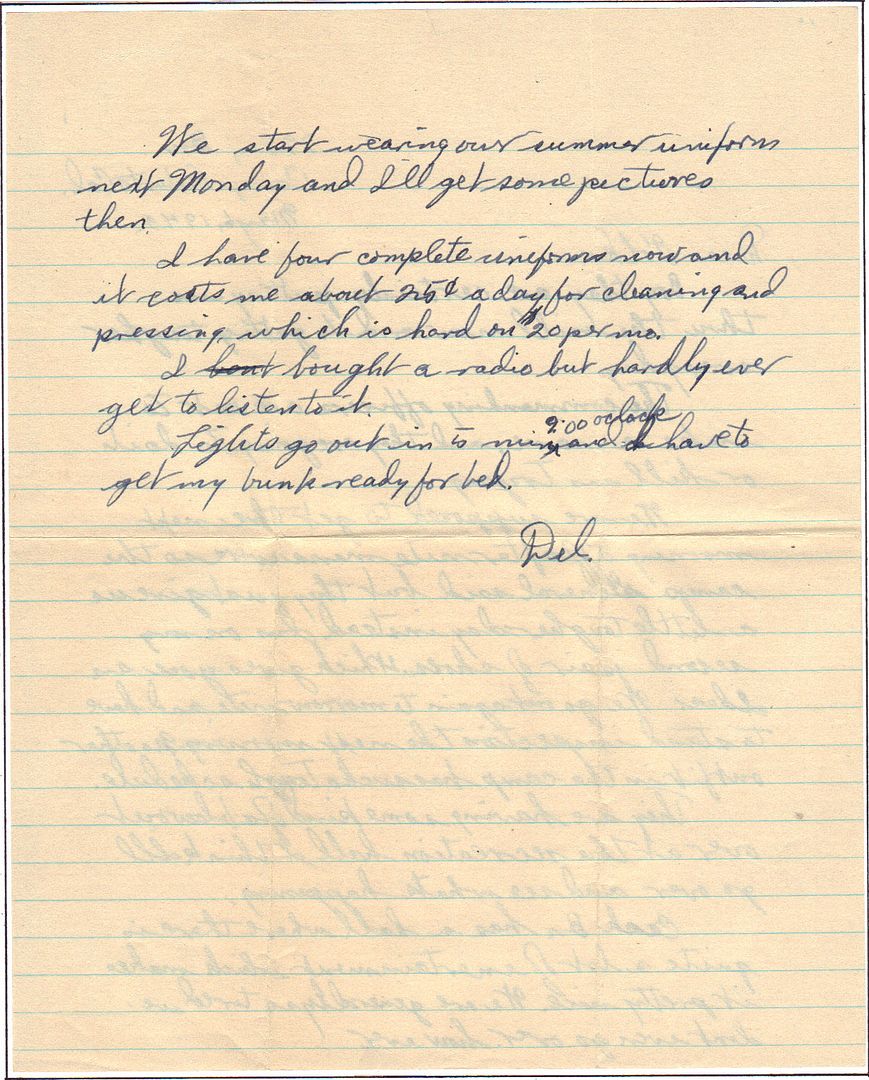
Two copies of the following postcard were also mailed today. The first was enclosed with the letter and says:
“79th Battalion area between two lines. Arrow points to my mess hall. My barracks is square behind it and not visible. Open area is ½ mile by mile paved parade ground. They take us out there at mid-day and drill us for an hour then sit us down and lecture us for an hour and as the thermometer is generally around 100° the seat of our pants leave tracks in the pavement. About on half of camp is visible in the picture.”
The other postcard was mailed to Homer’s aunt and uncle (Homer’s father’s sister and BIL) in Medical Springs, OR, and had the following message:
“I’m having an awful time trying to keep up correspondence. Don’t have too much time. Maybe I’ll get around to write a letter next Sun.
“Send some pictures of anything interesting around the place. I’m going to forget what home is like.”
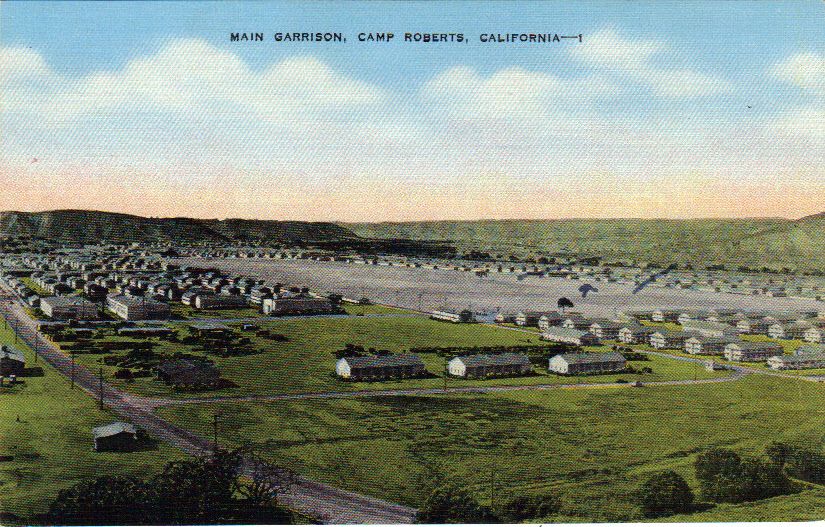
http://www.onwar.com/chrono/1942/may42/f06may42.htm
Corregidor surrenders to Japanese
Wednesday, May 6, 1942 www.onwar.com
In the Philippines... Formal American resistance to the Japanese invasion ends with General Wainwright’s surrender on Corregidor. Japanese attacks continue against local resistance on Mindanas.
http://homepage.ntlworld.com/andrew.etherington/frame.htm
May 6th, 1942
UNITED KINGDOM: AA cruiser HMS Sirius commissioned. (Dave Shirlaw)
FRANCE: Paris: The Reich security chief, Reinhardt Heydrich, arrives and places SS Major-General Karl Oberg in charge of police forces in France.
GERMANY: U-263, U-337 commissioned. (Dave Shirlaw)
MEDITERRANEAN SEA: Submarine HMS Urge left Malta on 27 April 1942. She failed to arrive at Alexandria on 6 May and was reported overdue on that day. Most likely she was lost on Italian mines off Malta. There is also a possibility that she was sunk 29 April off Ras el Hilal, Libya by Italian aircraft or that she was sunk by the Italian torpedo boat Pegaso in the eastern Mediterranean. (Dave Shirlaw)
CHINA: Attacks on seven cities yesterday signalled the start of an offensive along a 400-mile front by Chinese forces led by General Chiang Kai-shek against the Japanese occupation forces.
Shanghai and Nanking were among the cities raided, with Japanese communications and munitions supplies among the principal targets. Nanking, captured by Japan more than four years ago, is the seat of Wang Chingwei’s puppet government set up with Japanese support.
CAPT Milton Miles arrives in Chungking, China, to begin building an intelligence and guerilla training organization, Naval Group China. (Dave Shirlaw)
COMMONWEALTH OF THE PHILIPPINES: General Wainwright surrenders on Corrigedor with 15,000 American and Filipino troops. The island fortress’ defences weakened by a 27-day artillery barrage, were breached last night by Japanese commandos.
Lt-Gen Jonathan Wainwright, the US commander, decided to surrender this morning after radioing President Roosevelt and General MacArthur. He told them he feared that his whole garrison might be killed. As he spoke several hundred Japanese were machine-gunning the eastern entrance of the Manilta Tunnel, Corregidor’s underground gallery which was sheltering 6,000 administrative staff untrained for combat and 1,000 sick and wounded. The president told Wainwright: “You have given the world a shining example of patriotic fortitude and self-sacrifice.”
The fall of Corregidor has been anticipated since Bataan surrendered 27 days ago. Since then the island, only two miles away, has had 300 air raids and been hit by 300 shells a day, it’s green hills turning into a bleak moonscape. Yesterday’s landings followed a day of 13 air attacks. Coming ashore under a bright moon the enemy was hit by two concealed 75mm guns which inflicted hundreds of casualties - but not enough to stem the attack.
The river gunboats USS Oahu (PR-6) and USS Luzon (PR-7) and the minesweeper USS Quail (AM-15) are scuttled in Manila Bay. The commanding officer of the USS Quail, Lieutenant Commander John H. Morrill, another officer and 16 enlisted men, escape Manila Bay in a 36-foot (11 m) motor launch from Quail. (Jack McKillop)
Text of Wainwright’s Message to Roosevelt:
6 May 1942
For the President of the United States:
It is with broken heart and head bowed in sadness, but NOT in SHAME, I report to Your Excellency that I must go today to arrange terms for the surrender of the fortified islands of Manila Bay: Corregidor (Fort Mills), Caballo (Fort Hughes), El Fraile (Fort Drum), and Carabao (Fort Frank).
With anti-aircraft fire control equipment and many guns destroyed, we are no longer able to prevent accurate aerial bombardment. With numerous batteries of the heaviest calibre emplaced on the shores of Bataan and Cavite out ranging our remaining guns, the enemy now brings devastating cross fire to bear on us.
Most of my batteries, seacoast, anti-aircraft and field, have been put out of action by the enemy. I have ordered the others destroyed to prevent them from falling into enemy hands. In addition we are now overwhelmingly assaulted by Japanese troops on Corregidor.
There is a limit of human endurance and that limit has long since been past.
Without prospect of relief I feel it is my duty to my country and to my gallant troops to end this useless effusion of blood and human sacrifice.
If you agree, Mr. President, please say to the nation that my troops and I have accomplished all that is humanly possible and that we have upheld the best traditions of the United States and its Army.
May God bless and preserve you and guide you and the nation in the effort to ultimate victory.
With profound regret and with continued pride in my gallant troops I go to meet the Japanese commander.
Good-by Mr. President.
Jonathan M. Wainwright
Lt. General USA
Allied commander in the Philippines
(William L. Howard)
NEW GUINEA: Jack McKillop adds:
In the Coral Sea, Rear Admiral Frank Jack Fletcher, commanding Task Force 17 in the aircraft carrier USS Yorktown (CV-5), gathers all Allied forces under his tactical command. Carrier aircraft from the USS Lexington and USS Yorktown plus USAAF reconnaissance aircraft continue their search for the Japanese Port Morsesby invasion force. At 1030 hours local, three Australia-based USAAF B-17s find the light aircraft carrier HIJMS Shoho and her escorts and make a high-altitude attack but inflict no damage. The sighting is reported and forwarded to the navy.
AUSTRALIA: General MacArthur, the C-in-C of Allied Forces in the South-west Pacific, is given wide powers of censorship.
U.S.A.: The motion picture “Take a Letter, Darling” is released in the U.S. Directed by Mitchell Leisen, this comedy stars Rosalind Russell, Fred MacMurray, Constance Moore, Robert Benchley, Macdonald Carey and Dooley Wilson (the “pianist” in “Casablanca”). The plot has Russell, an advertising executive, hiring struggling painter MacMurray as her secretary. The film is nominated for three technical Academy Awards. (Jack McKillop)
Washington: The Secretary of the Navy sends dispatch 062230 transmitting ALNAV 97 directing the removal of the red circle in the white star and the horizontal red and white stripes on the rudders of Navy aircraft. (Jack McKillop)
Minesweeper USS Swallow launched.
Destroyer USS Johnston laid down. (Dave Shirlaw)
ATLANTIC OCEAN and CARIBBEAN SEA: Three more U.S. unarmed merchant ships are sunk by German submarines. A tanker is sunk off Florida, a freighter is sunk in the Gulf of Mexico and another freighter is sunk in the Caribbean. (Jack McKillop)
At 1855, a lookout on the unescorted and unarmed Alcoa Puritan spotted a torpedo passing approximately 15 feet astern about 15 miles off the entrance to the Mississippi River. The master immediately ordered full speed and swung the ship to keep the U-boat dead astern to present as small a target as possible. U-507 surfaced and began to overtake the freighter that was running at 16.5 knots. Five minutes the U-boat began to shell the ship from a distance of one mile. In 40 minutes, about 75 rounds were fired, scoring about 50 hits and disabling the steering gear. Two of the crewmembers suffered minor shrapnel injuries. The crew of ten officers, 37 crewmen and seven passengers abandoned ship in one lifeboat and two rafts. At 19.43 hours, a torpedo was fired, which struck below the #4 hatch and caused the ship to sink stern first in eight minutes. U-507 then approached the survivors and a German officer with a megaphone shouted “Sorry we can’t help you - hope you get ashore” and waved as the U-boat sailed away. All hands were picked up by USCGC Boutwell the same day and landed at Burrwood, Louisiana, after a patrol bomber had spotted them. The passengers were repatriated seamen from the American steam tanker T.C. McCobb, which was sunk by the Italian submarine Pietro Calvi 600 miles off British Guyana 31 Mar 1942.
At 0935, the unescorted Amazone was hit on the port side by a torpedo from U-333 and sank within two minutes off Miami. 14 crewmembers were lost (twelve men from the Dutch Antilles, one Dutch gunner and one Swiss crewman). The survivors were picked up by submarine chaser USS PC-484 and landed at Miami.
At 1125, the unescorted and unarmed Halsey was hit by two torpedoes from U-333 off Jupiter Inlet, Florida, while proceeding on a nonevasive course at 10.5 knots in bright moonlight. The torpedoes struck close together on the port side at the #2 and #3 main tanks. The explosion ripped a hole in the side 60 feet long. The master stopped the engines and headed toward the shore. No distress signal was sent, because the radio antenna had been destroyed. The entire crew of eight officers and 24 men abandoned ship in two lifeboats 15 minutes after the attack, the other two boats had been destroyed by the explosions. The men were nearly asphyxiated by the naphtha fumes before they could clear the ship. After one hour, the U-boat came alongside the lifeboats and offered assistance, but it was declined. The survivors recounted that the calcium lights on the lifebuoys ignited the naphtha two hours later. The tanker exploded amidships, broke in two and burst into flames both fore and aft. At the time of the explosion, USS PC-451 had approached the lifeboats but had to immediately investigate a probable sighting of a conning tower. Two fishing vessels later took the lifeboats in tow and brought them to the Gilbert Bar Lifeboat Station.
At 0543, the unescorted Java Arrow was torpedoed twice by U-333 eight miles off Vero Beach, Florida. The first torpedo struck on the port side about 15 feet above the keel at the #5 tank, just aft of the bridge. The second struck on the port side about ten feet above the keel and demolished the engine room, killing two officers on watch below. Some of the surviving seven officers, 32 crewmen and six armed guards (the ship was armed with one 4in and four .30cal guns) abandoned ship after 20 minutes in a first lifeboat, the remaining men followed ten minutes later in a second boat. The survivors were picked up by USS PC-483 and a USCG craft and landed at Miami and Fort Pierce, Florida. A USCG officer boarded the tanker to ascertain the damage and concluded she could be saved, so the master and four men returned to the ship and dropped the starboard anchor to prevent the ship going aground on the beach. The master went to Fort Pierce to arrange the salvage tugs and returned later with 14 men. They cut through the anchor chain with an acetylene torch and remained on board. The tugs Ontario and Bafshe towed the tanker, escorted by USCG vessels, to Port Everglades, Florida arriving after 90 hours. In June 1942, the Java Arrow was given to the US Maritime Commission, repaired and returned to service in 1943 as Kerry Patch. 1944 renamed Celtic, but changed name again to Kerry Patch in 1945.
ASW trawler HMS Senateur Duhamuel sank following collision off Morehead City, North Carolina. (Dave Shirlaw)
http://concretebattleship.vcwsg.org/King_02d.htm
The surrender of Fort Drum.
At 1140, 6 May 1942, the Fort Commander of Fort Drum was summoned to the telephone and told by the High Command to demolish the armament on Fort Drum in accordance with pre-arranged plans. We were told to complete the demolition and surrender by 1200. This gave us exactly 20 minutes. Each officer on the Fort, assisted by a few key enlisted men took certain material which had been prepared in advance and proceed to complete the job. The recoil cylinders of the guns were drained and obstructions placed in their muzzles. Then the guns were loaded with a round and fired by means of electrical primers with long wires attached, so that they might be fired from the light switches in the center of the ship on the “Typhoon Deck.” All of the guns on the Fort were handled in this manner, except the 3-inch battery and the 6-inch gun in Battery Roberts on the south side. The 3-inch battery had sustained a hit on the breech from a Japanese bomb some 25 minutes prior to the surrender order. The breech of the 3-inch gun was thrown over board and all the mechanism and the breech recess were sledged with a heavy sledge-hammer. The upper 6-inch gun in Battery Roberts had been permanently put out of action by Japanese artillery fire. All the communications material was smashed and thrown over the side. The plotting room, with all of its’ equipment, was cut into small bits with an axe, all of the records were thrown into the water. All of the small arms ammunition was carried to the top deck and thrown over the side. The remaining 14-inch powder cans had their tops taken off and buckets of salt water were poured into the cans with the powder. The 6-inch powder magazines were flooded with salt water from the sprinkler system, but the result of this was unknown.
Again, thanks for sharing the letters from your dad.
http://en.wikipedia.org/wiki/USS_Neosho_%28AO-23%29
As the American and Japanese fleets sought each other out in the opening maneuvers of the climactic Battle of the Coral Sea on 6 May 1942, Neosho refueled the carrier Yorktown and heavy cruiser Astoria, then retired from the carrier force with a lone escort, the destroyer Sims.
The item about the Catholic priest is a bit lacking in historical accuracy, isn’t it? Perhaps some of the experts here can help sort the wheat from the chaff.
Starting with the easiest, Dachau wasn’t a death camp. Over it’s span, it had a death rate somewhere between 20% and 25% from all causes. It was the first concentration camp, but it certainly wasn’t a death factory.
It’s been a while, but it is my recollection from a visit there some years ago that they didn’t use the gas chamber there.
I’d also question the alleged cause of the arrest. There was likely more to it than being arrested ‘for his faith’. The fact that he was a Slavic intellectual probably had a good bit more to do with it.
If one is making ‘saints’ for political reasons, I guess it’s ok to stretch the facts.
If I cross-referenced the information correctly, the Bataan Death March was happening when Corregidor fell...
Yup that is correct. My math teacher is junior high school (all three years) was on Corregidor when it fell. He spent his war years in a Manchurian prisoner of war camp. His stories were chilling.
Here’s to you Mr. Mulholland.
"So that's where we are to drive through, Herr Generaloberst?" asked Manstein's driver and general factotum, Fritz Nagel, after looking through the trench telescope at the observation post of 114th Artillery Regiment, which offered a good view of the Soviet positions.
"Yes, that's where we've got to drive through, Nagel." Manstein nodded. He pushed his cap back and once more pressed his eyes to the telescope through which he had just let his sergeant have a look.
Fritz Nagel was always welcome at all headquarters. A native of Karlsruhe, he had been Manstein's driver since 1938. Whenever Manstein drove to the front Nagel was behind the wheel. He was calmness personified, and had more than once handled dangerous situations. Several times he had been wounded. But Manstein himself had never even been scratched: Nagel was a kind of talisman. Manstein had driven out to the forward O.P. of 114th Artillery Regiment, in the sector of 46th Infantry Division, in the northern part of the front across the Parpach Isthmus, in order to have another look at the Soviet system of defenses. "Any other news?" he asked the commander of 466th Infantry Division. "Nothing special, Herr Generaloberst," Major-General Haccius replied.
"Well, good luck then, the day after tomorrow." Manstein nodded.
"Come on, Nagel; we're driving home."
The day after tomorrow—8th May, D-Day for "Bustard Hunt," the code name for the break-through to Kerch.
If one is dealing with an enemy three times one's own strength and established, moreover, in a cleverly constructed defensive position, one can dislodge him only by courage and cunning. Manstein therefore based his plan on cunning. The Soviet front in the isthmus had a curious shape: in its southern part it ran dead straight to the north, but in its northern part there was a big bulge to the west. This had originally been formed after the Soviets had dislodged the Rumanian 18th Division in the winter, and German battalions had only just been able to seal off the Soviet penetration.
The obvious move would have been to strike at the flank of this bulge. But just because it was the obvious solution— and because the Russians expected it and had concentrated two Armies as well as nearly all their reserves in this sector —Manstein resisted the temptation. The fact that he chose a different plan again showed him to be one of the outstanding strategists of the Second World War.
Naturally, Manstein did everything to confirm enemy reconnaissance in the belief that he was going to strike in the north. Dummy artillery emplacements were built, troop movements were staged in the northern and central sectors of the front, radio signals intended for the enemy's monitoring service were sent out, and dummy reconnaissance actions were carried out.
But Manstein meanwhile was preparing to attack at the other end, in the southern sector of the line. The XXX Army Corps under Lieutenant-General Maximilian Fretter-Pico was to punch a hole with its three infantry divisions—the 50th, the 28th Light, and the 132nd—into the line of the Soviet Forty-fourth Army. After that the 22nd Panzer Division under Major-General Wilhelm von Apell, as well as a motorized brigade under Colonel von Groddeck, was to sweep through this breach deep into the Soviet hinterland in order subsequently to turn to the north, enveloping the Soviet forces, and then break through farther to the east.
It was a bold plan—five infantry divisions and one Panzer division against three Armies. Stuka formations of VIII Air Corps under Colonel-General Freiherr von Richthofen and units of Major-General Pickert's 9th Flak Division were available to support the infantry. Heavy Army artillery was brought over from Sevastopol for a concentrated bombardment.
To deal with the main obstacle, the anti-tank ditch, Manstein had thought up a particularly cunning move.
There was a great deal of strange activity on the beach east of Feodosiya during the night of 7th/8th May. Assault craft were being pushed into the water, and sappers and infantrymen of the Bavarian 132nd Infantry Division were getting in. But the engines remained silent.
Boat after boat glided noiselessly away from the shore, propelled only by paddling. Soon the mysterious flotilla had been swallowed up by the night—four assault companies bobbing about on the Black Sea. Towards 0200 hours they were drifting along the coast to the east.
At 0315, like some primordial thunder-clap, the German artillery opened fire. Heavy mortars thundered, rocket batteries whined, AA guns hammered. Fire, smoke, and morning haze veiled the southern sector of the Parpach Isthmus. Stukas roared overhead and plummeted down. Their bombs tore into strongpoints and wire obstacles. At 0325 hours pairs of white signals went up everywhere: the German infantry was attacking. Right in front went the sappers. Theirs was the worst job—removing the mines and cutting the wire, always under enemy fire.
The Russians were putting up a barrage from all weapons. The Soviet machine-gunners behind the firing-slits of their pillboxes merely had to squeeze the trigger. They did not have to take aim. Their guns were emplaced for cross-fire, covering between them the entire forefield. All they had to do was shoot. Soviet naval guns opened up. Mortars plopped. Shells, bombs, and bullets swept over the narrow neck of land across which the Germans must attack. Surely there was no other approach.
The moment the German artillery bombardment began the assault boats off the coast started up their engines. The Russians could not possibly hear the engine noise now. Swift as arrows the boats streaked to the coast—towards the precise spot where the Soviet anti-tank ditch ran into the sea, wide as a barngate and filled with water. The assault boats simply sailed into the ditch. The men leapt out and immediately started firing their machine-guns from their hips. The Soviets in their infantry dug-outs along the edge of the ditch were mown down before they even realized what was happening.
But there a built-in Russian flame-thrower opened up.
The first German wave pressed themselves to the ground. They were pinned down.
A Messerschmidt fighter was coming in at low level from the sea. It roared along the trench, its guns blazing, and forced the Soviets to take cover. The men of the German assault-boat commando leapt to their feet and burst into the trench. The first Russians raised their hands. There was utter confusion.
On the left of 132nd Infantry Division, along both sides of the Feodosiya-Kerch road, the 49th Jäger Regiment of the Silesian 28th Light Infantry Division was meanwhile working its way through the minefields. Captain Grève was leading the spearhead of 1st Battalion south of the road. He was racing through the enemy fire, along the narrow cleared lanes through the minefield. The division had been assigned some self-propelled guns from Assault Gun Battalion 190. Lieutenant Buff, in charge of three of these steel fortresses, was advancing alongside the 1st Battalion, providing fire cover for Greve's men. By 0430 hours the Jägers had reached the anti-tank ditch. Panting, the captain was lying by the edge. Sergeant Scheidt with his machine-gun was firing right and left. Sappers came running up with an assault ladder. Grève was the first to slide down into the ditch.
Major Kutzner, the commander of the 2nd Battalion, was severely wounded by the "Tartar Hill." There the Soviets had emplaced the anti-tank guns of an entire anti-tank regiment. The situation was saved by Second Lieutenant Fürnschuss with his self-propelled guns of Assault Gun Battalion 190. His 7.5-cm. long-barrel cannon shot up the Russian antitank guns. First Lieutenant Reissner was charging at the head of his 7th Company. He ran through heavy enemy artillery-fire and flung himself down. He leapt to his feet again and ran on. There was the anti-tank ditch. Its edge had been smashed by gunfire. Reissner let himself roll down. A burst from a machine pistol cut him down. Though wounded, he continued to wave his Jägers on against the Soviet infantry dugout.
The 50th Infantry Division, on the left flank of the penetration area, was advancing through minefields and wire obstacles. Well-camouflaged machine-gun positions, which had survived the artillery barrage, caught them in enfilading and cross fire. The 1st Battalion, 123rd Infantry Regiment, suffered heavy casualties and was halted.
Lieutenant-Colonel von Viebahn, the regimental commander, was obliged to tackle the Soviet machine-gun posts by an attack at right angles to the front. By nightfall the 3rd Battalion eventually succeeded in penetrating as far as the anti-tank ditch. Second Lieutenant Reimann with his 9th Company and parts of 10th Company, likewise put under his command, rolled up the Soviet positions along the ditch from the regiment's right wing as far as Lake Parpach; in furious hand-to-hand fighting he silenced all the machine-gun emplacements and strongpoints built into the anti-tank ditch and finally blasted the walls of the ditch to enable German armor to cross. The key obstacle of the Soviet defenses had thus been taken along the whole front of the attack.
The companies of Colonel von Groddeck's Motorized Brigade—composed of Rumanian and German units, such as the Reconnaissance Detachment of 22nd Infantry Division— had managed, on the very afternoon of the first day of the attack, to reach the seashore in the sector of 132nd Infantry Division at the spot where earlier that day the assault boats had seized the anti-tank ditch, to clear the obstacle by quickly built crossings and to strike at the rear of the Soviet positions.
The spearheads of 22nd Panzer Division meanwhile were still waiting for their order to attack. But not until mid-morning of 9th May had the bridgeheads in the sector of the 28th Light and 50th Infantry Divisions been sufficiently enlarged to allow the rest of the units to be brought forward. The Panzer companies and armored cars deployed rapidly, burst into the Soviets' second and third lines of defense, broke all resistance, reached the road bend to Arma-Eli, and crashed right into the assembly area of a Soviet armored brigade. As if the move had been rehearsed, six steel giants of Assault Gun Battalion 190 under Captain Peitz arrived on the scene at exactly the same moment. Before the Soviets could take up position they were smashed by the German tanks and assault guns.
As planned, 22nd Panzer Division now turned northward, behind the front of the two Soviet Armies which were still engaged with the Franconian-Sudeten 46th Infantry Division and the Rumanian brigades. Everything went according to Manstein's plan. But then abruptly the pattern changed. In the late afternoon of 9th May heavy spring rain began to fall. Within a few hours the tracks and the clay soil had turned into a bottomless morass. Jeeps and lorries were completely bogged down, and only tracked vehicles were able to make any progress. It was now Manstein's will against the forces of nature.
The armored fighting vehicles of 22nd Panzer Division continued to struggle forward until late at night, and then took up position for all-round defense. Thus, when a clear day dawned on the following morning, 10th May, they were already deep in the flank and rear of the Soviet Fifty-first Army. A Soviet relief attack with strong armored forces was repulsed. Wind sprang up and soon dried the soil. The division moved on towards the north. On 11th May it was at Ak-Monay by the sea, and thus in the rear of the Soviet Forty-seventh Army. Ten Russian divisions were in the bag. The remainder fled eastward. With this bold stroke the 22nd Panzer Division had wiped out a blot on its escutcheon—a blot dating back to 20th March 1942. On that day the newly organized Division, dispatched to the Crimea by the High Command of the Army without a single divisional exercise or even a test of co-operation between its formations, had been employed by Eleventh Army for a counter-attack on the Parpach front.
In the morning mist the formations had encountered Soviet forces preparing for an attack; they had got confused and had been shot up by the enemy. Field-Marshal von Manstein later admitted that it had been a mistake to send such an inexperienced division into a major operation. But what use was this admission by the Commander-in-Chief? Among the front-line formations of Eleventh Army the 22nd Panzer Division had been looked down upon since 20th March. Among the High Command of the Army it had likewise been in bad odor since that day. All the gallantry displayed by the division during the later part of the winter had been of no avail: the stigma of 20th March continued, unjustly, to stick to them.
Meanwhile Colonel von Groddeck and his fast brigade were boldly chasing eastward and preventing the Russians from establishing a line farther back. Wherever Soviet regiments tried to dig in von Groddeck struck. And then he raced on.
When the brigade had driven 30 miles deep into the hinterland and quite unexpectedly arrived at the "Tartar Ditch"— far behind the headquarters of Lieutenant-General D. T. Kozlov, the Commander-in-Chief Soviet Army Group Crimean Front —the Soviet command lost its nerve.
Troops and headquarters disintegrated. Along the roads vast columns of fleeing formations were moving in the direction of Kerch, towards the eastern coasts of the peninsula. From there they hoped to save themselves across the straits to the mainland. Desperately, Soviet tactical reserves attempted to halt the German spearheads, to enable as many formations as possible of the vast numbers accumulating on the beaches of the Kerch Peninsula to be ferried across to the mainland in motor-boats and light craft. They were hoping to repeat the feat accomplished by the British at Dunkirk almost exactly two years before. But Manstein had no intention of having his victory diminished by any Soviet Dunkirk. He sent his armored and motorized units, as well as Major-General Sander's North German 170th Infantry Division with 213th Infantry Regiment, to pursue and overtake the retreating Russians. But Colonel von Groddeck was no longer of the party. He had been severely wounded, and died of his wounds shortly afterwards.
On 16th May Kerch was reached. The Soviet High Command did not succeed in pulling off a Dunkirk. Stalin was unable to save his Armies. The assault guns of XXX Army Corps, of Assault Gun Battalions 190, 197, and 249, soon put an end to the enemy's improvised naval transports.
The prize of the victory was 170,000 prisoners, 1133 guns, and 258 tanks. Three Soviet Armies had been defeated by half a dozen German divisions in eight days.
Early in the morning of 17th May Manstein and Colonel-General Freiherr von Richthofen were standing on a slight hill near Kerch. Before them lay the sea, the Kerch Strait, and beyond, barely 12 miles away, under a brilliant sun was the shore of the Taman Peninsula, the approaches to Asia, the gate to the Caucasus. With his victory Manstein had burst open the back-door to Stalin's fabulous oilfields.
At that very hour, when Manstein was gazing across to his great objective, 400 miles farther north, in the Kharkov area, the divisions of von Kleist's Army Group were mounting their attack which was to gain them the vital starting-line on the Donets for their summer offensive.
To Be Continued- Kharkov-A Calculated Risk
German troops at an improvised grave-site (March 1942)
German divisional cemetery-Spring 1942
An engine for a panzer is unloaded from a Ju-52. Difficult terrain and weather, poor roads, and increasing partisan activity made aerial resupply essential for panzer spearheads throughout Barbarossa.
Fallen German soldier 1942
It was imperative to always confirm so-called "dead" Soviets were really dead. There were many instances of supposedly dead or wounded Soviet troops firing on or tossing grenades at German troops when their backs were turned.
Captured Soviet troops taken during an early morning attack on one of the many small towns in the Donets Basin-March 1942
Russian night attack on a German held village south of Kursk Spring 1942
German dead, victims of Soviet artillery-Crimea-spring 1942
AA position next to a swollen river somewhere near the Sea of Azov. winter-spring of 1942
German church service in the field -Ukraine-summer 1942
Germans removing Russian civilians from a town prior to an imminent Soviet attack -May 1942
German anti-tank unit set up near village exit-Spring 1942
According to my notes the Death March took place in the three days following the surrender of Bataan. April 10-12, 1942.
You are correct. The Bataan Death March began immediately after the surrender of the troops on the Bataan Peninsula by General King on April 9th.
Here's a rather famous photo photo taken during the liberation of Dachau in 1945.

The chamber had a bin mechanism for the use of Zyklon-B like was similar to one used at Auschwitz.


This was the delousing room which is complete with venting and fake shower heads suggesting that it could have been used on humans.


Finally, there is this letter that can be found in the Bundesarchiv in Koblinz which suggest the chamber was being used and even suggested expanding its purpose (Dr. Sigmund Rascher was an SS Doctor at Dachau who was executed after the war in the same camp for his medical experimentation on inmates at the facility):
Dr. Sigmund RascherMunich
Togerstr. 56
August 9, 1942
Esteemed Reichsführer!
As you know, the same installation as in Linz is to be built in Dachau. As the 'invalid transports' terminate in the special chambers anyway I wondered if it would be possible to test the effects of our combat gases in these chambers using the persons who are destined for those chambers anyway. The only reports which are available so far are for experiments on animals or of accidents in the manufacture of these gases.
(signed)
S. Rascher
If this actually happened is anyone's guess.
I got the impression from Toland's book that the transfer of prisoners only lasted about three days. Corregidor held out almost another month.
Disclaimer: Opinions posted on Free Republic are those of the individual posters and do not necessarily represent the opinion of Free Republic or its management. All materials posted herein are protected by copyright law and the exemption for fair use of copyrighted works.